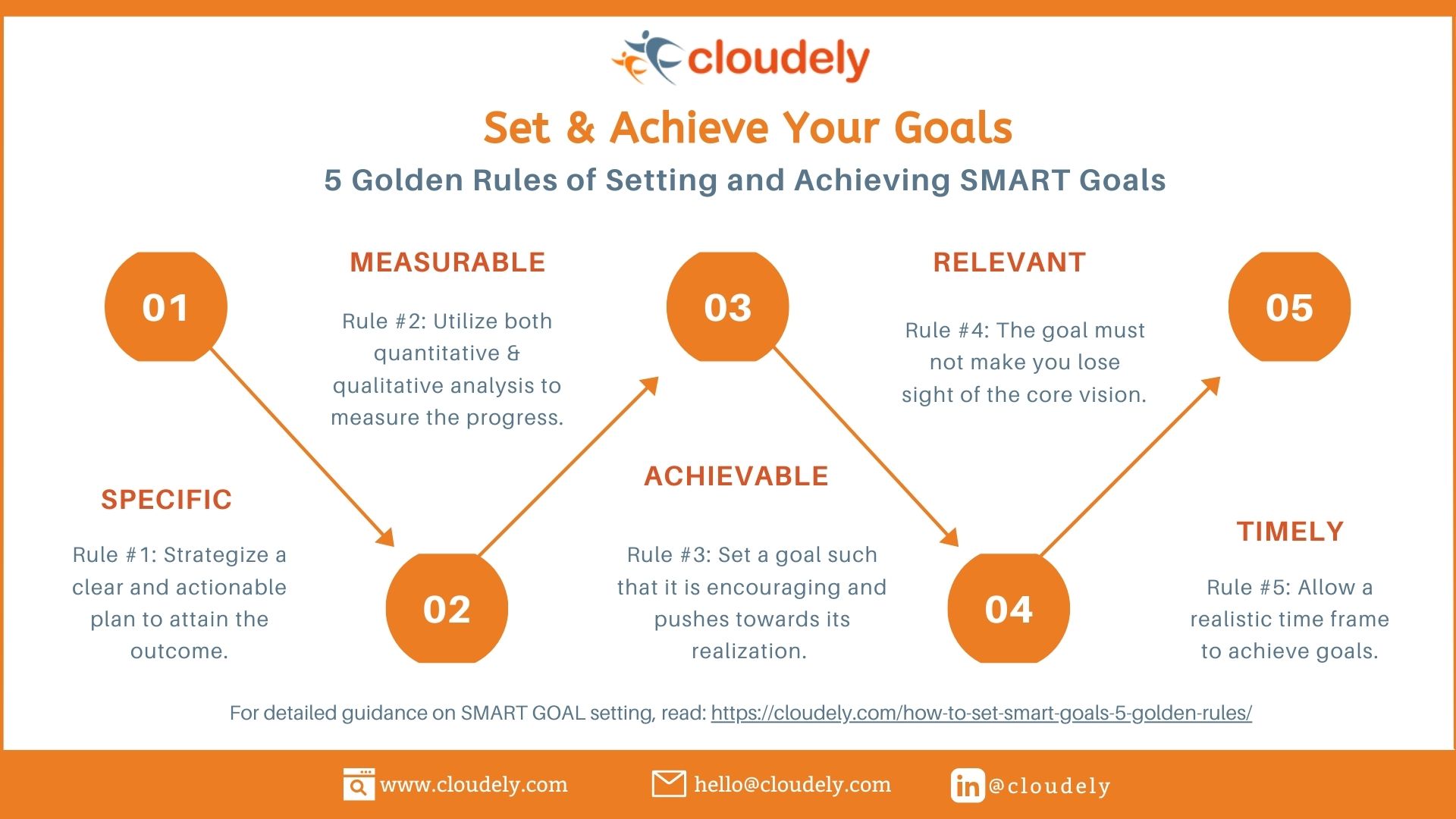Setting goals is vital in realizing a dream. Goals give us the direction to move ahead in life and career. Whether to grow in personal or professional life, goal setting is crucial.
However, we must recognize that goals without a plan may remain wishes. Here’s why the emphasis on setting SMART goals is assuming importance.
This post guides you on how to set SMART goals with relevant professional and personal SMART goal examples.
Table of Contents
What are SMART goals?
SMART is an acronym that stands for Specific, Measurable, Achievable, Relevant, and Timely. SMART goals carry all these attributes and provide the requisite clarity and urgency to accomplish them.
The SMART Criteria
When you set SMART goals, your plan of action to accomplish them becomes comprehensible. Here are the criteria for how to set SMART goals.
S: Specific
It is often said – “If the plan doesn’t work, change the plan but not the goal.”
But, when your plan of action is specific, the goal is bound to be met.
When the why is clear, the how becomes easy. Hence, narrow down what you want to achieve and why.
To set ‘specific’ SMART goals, work on:
- What is the result you envision?
- What steps are needed to reach the result?
Rule #1: Strategize a clear and actionable plan to attain the outcome.
For instance: ‘I want to lose weight’ is a vague goal. It does not tell you how you are going to achieve it.
Now, let’s make this goal specific: “I want to lose 8 pounds by dedicating 45 minutes to exercise daily.”
This goal tells you:
- the outcome – that you want to lose 8 pounds, and
- the plan of action – by exercising daily for 45 minutes.
M: Measurable
That which can be measured can be improved. When planning how to set SMART goals, you must have a clear sense of tracking their progress.
To set ‘measurable’ SMART goals, work on:
- What data proves the progress of your goal?
- How will you show the difference at different stages between the start of the task and its end?
For instance, in the above-mentioned scenario, you could track the weight loss at regular intervals to observe how well you are heading towards the outcome.
Rule #2: Utilize both quantitative and qualitative analysis to measure the progress.
For business SMART goals, methods such as surveys, audits, testimonials, samples, and feedback often help measure the goal progress.
For instance, the measures can be tracking the increase in the number of subscribers, positive reviews received, traffic to a website, or the percentage of the deals closed.
Related Read: How to set SaaS OKRs?
A: Achievable
A goal must be encouraging and push us towards its realization. Setting no goals is better than setting impractical goals.
Too big goals might result in demotivation and discontinuation of efforts. Achievable goals are perceivable and attainable.
It is why you must set ‘achievable’ goals when planning how to set SMART goals.
Rule #3: Set a goal such that it is encouraging and pushes towards its realization.
To set ‘achievable’ SMART goals, work on:
- Can you achieve the goal on your own?
- Do you possess the required capabilities?
- What else would you need to achieve the goal?
- Are the extra efforts realizable?
For instance, in the example above, you must check:
What do you need to achieve the result – diet and nutrition guidance, fitness or yoga expert help, health check?
Speaking in terms of how to set SMART goals for work and business, here’s what you need to do to make your goal achievable:
- Do you need team members’ inputs to achieve the goals?
- If yes, do you have all the required facilities, tools, and skills to achieve them?
R: Relevant
For instance, in the example above, you must check: is 8-pound weight loss relevant to your age and health condition?
To set ‘relevant’ SMART goals, work on:
- Is the goal in alignment with your business needs?
- How good is the goal matching with the earlier results?
Say you plan to increase your sales by next quarter to 45%. However, the historical trends reveal if your sales never crossed 6%-8% in a quarter, then you must think twice about setting the goal as 45%.
While setting ‘relevant’ SMART goals, it is vital to assess your analytics, business vision along with capabilities.
Thus, we arrive at rule 4.
Rule #4: The goal must not make you lose sight of the core vision.
T: Timely
A goal without a timeline can remain just a wish. Setting ‘timely’ SMART goals are essential to create a sense of urgency in attaining them.
For instance, when planning to lose 8 pounds, mention the timeline you would want to achieve this. 1 month? 2 months?
If the goal has no timeline, the plan of action loses its vigour.
Rule #5: Allow a realistic time frame to achieve goals.
For instance, “We want to increase sales by 23% in the coming quarter.”
Notice the timeline here: “the coming quarter.”
Now the whole SMART goal in the example we have been discussing turns out to be: ” I want to lose 8 pounds in a month by exercising daily for 45 minutes and seeking a dietician’s guidance.”

Now that we know what SMART goals are and how to set SMART goals, let us discuss some more SMART goals for businesses that we can help with:
1. SMART Hiring Goal
Specific: We want to increase our headcount by hiring at least 10 candidates a month. Our recruiters will multiply their tasks from making one hire a week to two hires a week, and our HRs will increase their workload from interviewing six persons a week to eight posts a week.
Measurable: Our goal is a 6% increase in headcount.
Attainable: Our headcount increased by 3% last month when we changed our hiring speed from two to three times a week.
Relevant: By increasing headcount, we want to take up more projects, generate more leads, and close more deals.
Time-Bound: This Month End
SMART Goal: At the end of this month, our headcount will rise at least by 5% by turning our hiring frequency from five to ten candidates per month.
2. SMART Deal Closure Goal
Specific: We want to boost our deal closure rate by inspecting our current CPQ flow from 3 deals to 5 per month.
Measurable: Our goal is a 25% increase in lead conversion.
Attainable: When we overcome silos in our sales process and cut down quote generation time by 14%, our average deal closure time decreases by 30%.
Relevant: By improvising our sales process, we will boost customer engagement and brand reputation, attracting more customers.
Time-Bound: In the coming quarter.
SMART Goal: In 3 months, we will achieve a 30% decrease in deal closure time by improving silos in our sales process and making 5 deals per month.
3. SMART Technology Integrations Goal
Specific: I want to boost the customer relationship by increasing our investment in CRM technology.
Measurable: Our goal is a 40% increase in subscribers.
Attainable: Since we identified and started using this tactic 4 months ago, our customer retention has increased by 16%.
Relevant: By increasing customer generation and retention, our customer database widens, brand awareness grows, and bring in more leads to our sales team.
Time-Bound: Coming three months.
SMART Goal: In three months, we will see a 40% increase in customer engagement and retention by increasing our CRM technology budget by collaborating with proven technology partners.
Whether you are a budding entrepreneur, a start-up founder, or a medium-scale business owner wondering how to set SMART goals or looking for a trusted business partnership, we can help you.
Reach us at hello@cloudely.com with your business challenges. Let us together set SMART goals for your business and accomplish them.
About Us
Cloudely is a global leader in digital transformation. We offer cutting-edge technology , legal and compliance and hiring solutions to global businesses. Don’t forget to say Hello to us on LinkedIn.






